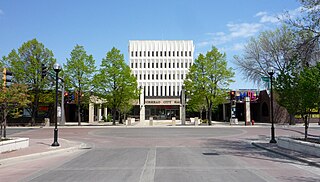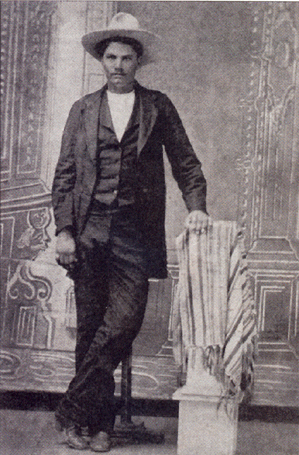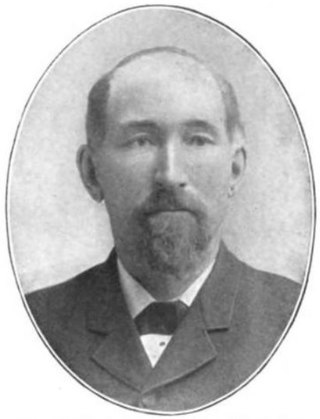Related Research Articles

Clay County is a county in the U.S. state of Minnesota. As of the 2020 census, the population was 65,318. Its county seat is Moorhead.

Moorhead is a city in and county seat of Clay County, Minnesota, United States, on the banks of the Red River of the North. Located in the Red River Valley, an extremely fertile and active agricultural region, Moorhead is also home to several corporations and manufacturing industries. Across the river from Fargo, North Dakota, Moorhead helps form the core of the Fargo–Moorhead ND-MN Metropolitan Area. The population was 44,505 according to the 2020 census.

The Great Northern Railway was an American Class I railroad. Running from Saint Paul, Minnesota, to Seattle, Washington, it was the creation of 19th-century railroad entrepreneur James J. Hill and was developed from the Saint Paul & Pacific Railroad. The Great Northern's route was the northernmost transcontinental railroad route in the U.S.

John Wesley Hardin was an American Old West outlaw, gunfighter, and controversial folk icon. Hardin often got into trouble with the law from an early age. He killed his first man at the age of 15, claiming he did so in self-defense.

Gunfighters, also called gunslingers, or in the 19th and early 20th centuries gunmen, were individuals in the American Old West who gained a reputation of being dangerous with a gun and participated in gunfights and shootouts. Today, the term "gunslinger" is more or less used to denote someone who is quick on the draw with a pistol, but can also refer to riflemen and shotgun messengers. The gunfighter is also one of the most popular characters in the Western genre and has appeared in associated films, video games, and literature.

The North Coast Limited was a named passenger train operated by the Northern Pacific Railway between Chicago and Seattle via Bismarck, North Dakota. It started on April 29, 1900, and continued as a Burlington Northern Railroad train after the merger on March 2, 1970 with Great Northern Railway and the Chicago, Burlington and Quincy Railroad. The next year, it ceased operations after the trains which left their originating stations on April 30, 1971, the day before Amtrak began service, arrived at their destinations.

Aakers College was a private two-year college with campuses in Grand Forks, North Dakota, Fargo, North Dakota and Bismarck, North Dakota. In 2007, it merged with Rasmussen College and is now known as Rasmussen College. The school offers associate degrees and bachelor's degrees in several fields.
Thomas Hilliard Moodie was born in Winona, Minnesota. After he was inaugurated Governor of North Dakota in January 1935, it was revealed that he had not officially been a resident of the state for the mandatory five years, and he was removed from office in February 1935 having served less than a month.

Solomon Gilman Comstock was an American attorney and politician who served as a member of the United States House of Representatives for Minnesota's 5th congressional district from 1889 to 1891.

Interstate 94 (I-94) runs east–west for 352.4 miles (567.1 km) through the southern half of the US state of North Dakota, from the Montana state line east to the Red River at Fargo. The route generally follows the route of the Northern Pacific Railway.

Fargo Station is a train station in Fargo, North Dakota, United States. It is served by Amtrak's Empire Builder. It is the only railway station in use in the Fargo-Moorhead area and is the third-busiest in North Dakota. The platform, tracks, and station are currently all owned by BNSF Railway. The station is currently located in the former BNSF freight house. The former main station building is now home to Great Northern Bicycle Co.

The family of Colt Pocket Percussion Revolvers evolved from the earlier commercial revolvers marketed by the Patent Arms Manufacturing Company of Paterson, N.J. The smaller versions of Colt's first revolvers are also called "Baby Patersons" by collectors and were produced first in .28 to .31 caliber, and later in .36 caliber, by means of rebating the frame and adding a "step" to the cylinder to increase diameter. The .31 caliber carried over into Samuel Colt's second venture in the arms trade in the form of the "Baby Dragoon"-a small revolver developed in 1847–48. The "Baby Dragoon" was in parallel development with Colt's other revolvers and, by 1850, it had evolved into the "Colt's Revolving Pocket Pistol" that collectors now name "The Pocket Model of 1849". It is a smaller brother of the more famous "Colt's Revolving Belt Pistol of Naval Caliber" introduced the same year and commonly designated by collectors as the "1851 Navy Model". In 1855 Colt introduced another pocket percussion revolver, the Colt 1855 "Sidehammer", designed alongside engineer Elisha K. Root.
John Bull (1836–1929) was a little-known yet nonetheless deadly English gunman of the American Old West. He is featured in the book "Deadly Dozen", written by author Robert K. DeArment as one of the twelve most underrated gunmen of the 19th century west.

Frank Jay Haynes, known as F. Jay or the Professor to almost all who knew him, was a professional photographer, publisher, and entrepreneur from Minnesota who played a major role in documenting through photographs the settlement and early history of the great Northwest. He became both the official photographer of the Northern Pacific Railway and of Yellowstone National Park as well as operating early transportation concessions in the park. His photographs were widely published in articles, journals, books and turned into stereographs, and postcards in the late 19th and early 20th century.

The Comstock House is a historic house museum in Moorhead, Minnesota, United States. It was built for Solomon Comstock and his family from 1882 to 1883 in a mix of Queen Anne and Eastlake style. Comstock (1842–1933) was one of Moorhead's first settlers and an influential figure in business, politics, civics, and education in the growing city and state.
Jonathan Twingley is an American artist, illustrator and author. His work is regularly exhibited in galleries and museums throughout the United States. His paintings and illustrations also appear in The New York Times, The Washington Post, The Los Angeles Times, The Wall Street Journal, The Atlantic Monthly, The New Republic, Mother Jones, and The Progressive.

Wallace Barton Douglas was an American lawyer, jurist, and politician.

Fighting Thru, also known as California in 1878, is a 1930 American pre-Code Western film directed by William Nigh and starring Ken Maynard, Jeanette Loff, and Wallace MacDonald. Its plot follows a gold miner from the California Gold Rush who attempts to save his partner and vie for the affections of a young frontier woman. The film was released by Tiffany Pictures in December 1930, and re-released in 1937 through Amity Pictures.

Martin Solan Hector was an influential citizen and businessman of Fargo, North Dakota. He first leased and then later donated land to the city for the airport, which still bears his name.
Merlyn Orville Valan was an American politician and farmer.
References
- 1 2 3 4 "The gunfight that created Clay County's government".
- ↑ "Sin cities: From prostitution to quickie divorces, exhibit details tawdrier side of Fargo and Moorhead". Grand Forks Herald. May 13, 2013.
- 1 2 3 The Morning Review, April 9, 1889, page 15 (Spokane newspaper)
- ↑ The Baltimore Bee, October 13 1877, page 3, "How Miners Keep Sunday"
- ↑ The Alexandria Post, Alexandria, Douglas County, Minnesota, Saturday 4 May 1872, page 4, col. 2.
- ↑ Prodgers, Jeanette (2009). Champion Buffalo Hunter: The Frontier Memoirs of Yellowstone Vic Smith (Revised ed.). Guilford CT 06437: The Globe Pequot Press. p. 44. ISBN 978-0-7627-4898-3.
{{cite book}}: CS1 maint: location (link) - ↑ "Shang Stanton and Colt Pistol Collection - MSS 682 | Historical and Cultural Society of Clay County". hcsmuseum.pastperfectonline.com.
- ↑ The Minneapolis Tribune, Minneapolis, Hennepin County, Minnesota, Tuesday 6 November 1877, page 4